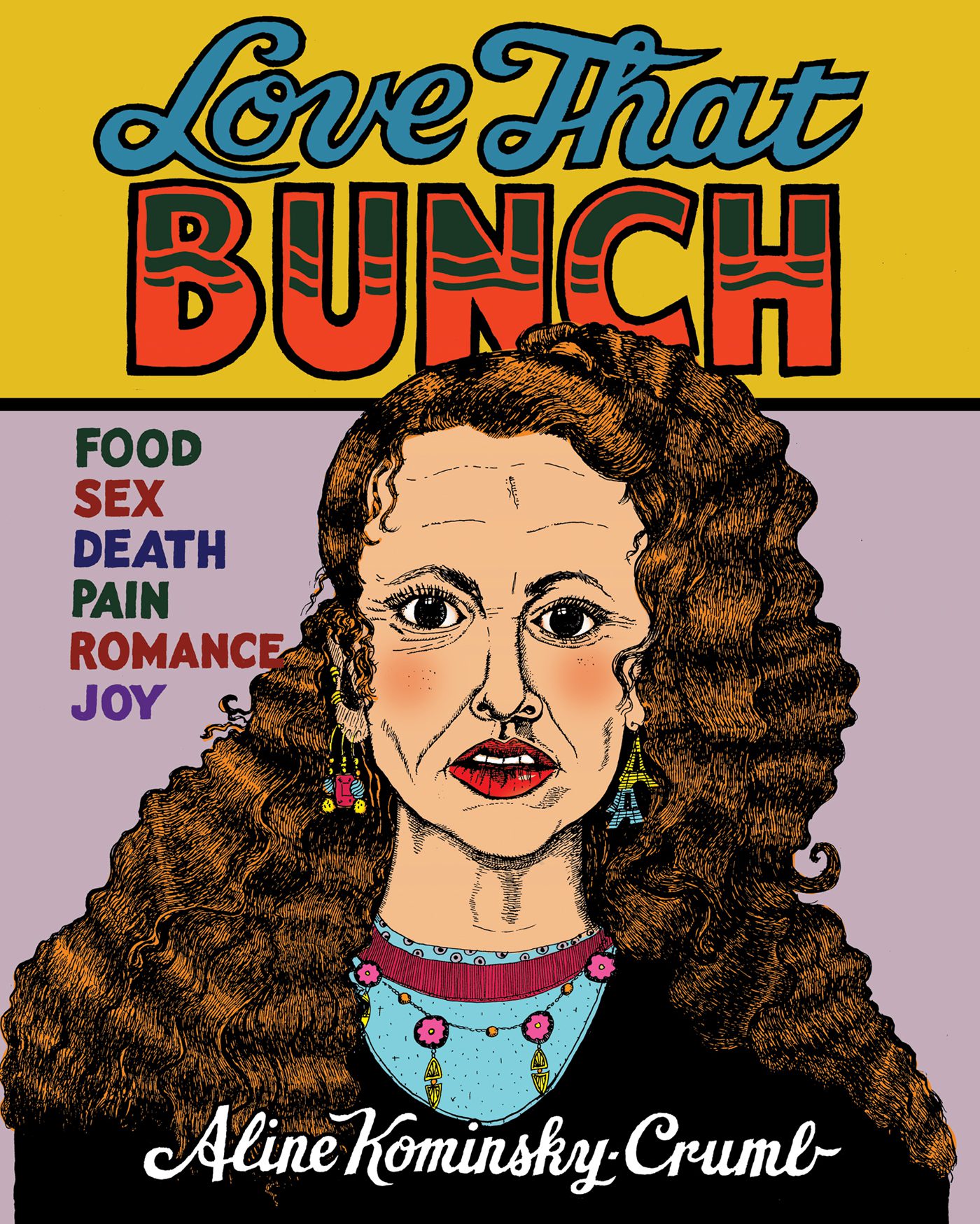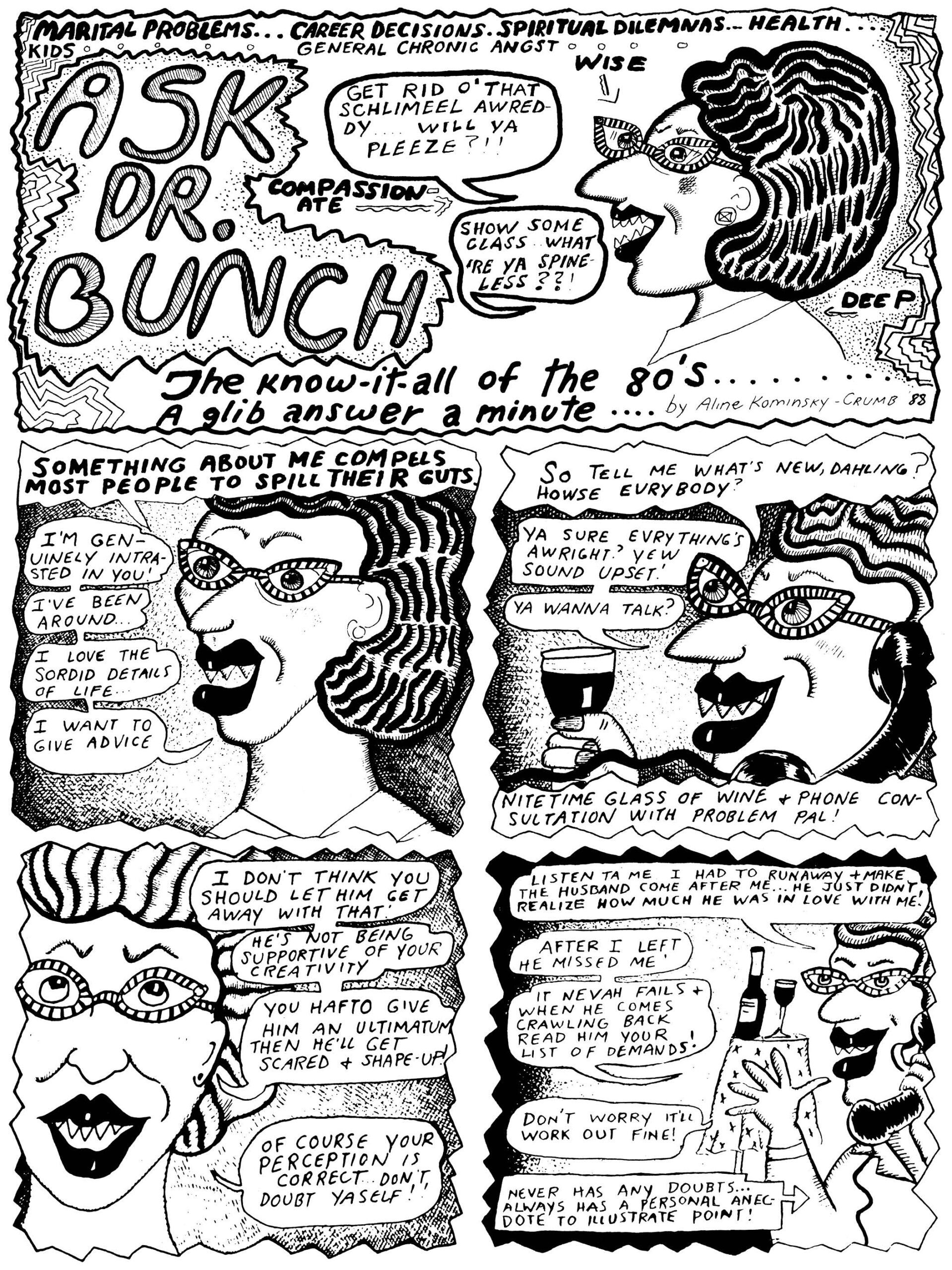Love That Bunch, a selection of Aline Kominsky-Crumb’s work spanning nearly a half-century, announces itself with gusto. In the first story, a teenage Bunch—Kominsky-Crumb, more or less—has sex in a car with Al, a high school classmate. Upon seeing his penis, the first she’d ever seen, she says, “It’s so ugly,” and thinks, “Looks like gizzards.” As the Bunch says “Don’t put it in!,” Al penetrates her. She says, “No no no” and “OW.”
The rest of the book is not precisely so brutal—a characterization I expect Kominsky-Crumb would dispute—but it always feels equally unvarnished, even though of course that’s illusory.
Kominsky-Crumb (who has been married for decades to Robert Crumb, another cartoonist, also of some renown) and I talked recently about drawing cancer, inadequacies of early work, and her burial wishes.
***
Aline Kominsky-Crumb: Can I ask how old you are? I’m really curious.
The Rumpus: I’m thirty-nine.
Kominsky-Crumb: Oh, okay. That’s so interesting because what’s been happening on this whole tour, the journalists and the people I’m talking to are getting younger and younger. One of the reasons why I did this tour was to see who was reading my work, because I haven’t had contact with the public in a long time.
It’s been really uplifting. I’ve had kids in their twenties who have read my work while they were studying at Harvard, where it’s on the curriculum, which really was an eye-opener for me.
Because I did that work in rebellion against art school and academia, and I expected people to read it on the toilet.
Rumpus: I think you were maybe forty-some-odd years ahead of your time, the extent to which you mined your life for stories.
Kominsky-Crumb: I agree with that.
Rumpus: In recent years, there’s been a lot of worry about writers are being exploited for their pain, basically. Somehow you’ve been able to do it on your own terms?
Kominsky-Crumb: I didn’t make a decision to work that way, or decide that I was gonna be a pioneer. That’s what came out of my pain and anger as an artist. I couldn’t find a really good form of expression in art school, because abstract expressionism is what was being taught at that time. So I just started writing in my notebooks and drawing and telling stories. Inspired more by Jewish stand-up comics than by art, or other comics actually, and that’s what came out of me without thinking about it all. It’s how I live with the discomfort of my childhood and youth.
Now I look back and I realize that was unique. I don’t know why no one else was working that way. The first comics I did were for Wimmen’s Comix, a women’s art collective, and a lot of the feminists in that group thought my work was too self-deprecating and they didn’t approve of it. And I said I really don’t have a choice—I really don’t know how to make things up. This is what comes out of me, and if you don’t want to publish it, I understand. But I’ll just keep doing this anyway, because this is really what I need to do now.
Rumpus: I love the arc of the book, because it starts with what seems like rape a couple of pages in, and then ends with domestic bliss.
Kominsky-Crumb: That’s an interesting way of looking at it. Someone asked me if I considered that first story rape, but I don’t, because I was so hot for that guy and I really wanted to do it with him even though he was a real cad and a serial deflowerer of younger women. I was really hot to trot.
It’s really a complicated situation, and it’s one of those gray areas where, yes, he was a nasty piece of work, but boy, I was so attracted to him, and I really wanted to have sex badly with him.
Rumpus: I didn’t want to seem definitive about it, because—
Kominsky-Crumb: You’re the second person. A woman friend of mine said she looked at that and thought, Boy, this would be considered a rape, and with what’s going on now, that’s totally how this would be looked at. But it wasn’t like that to me at all.
I don’t know if you could draw it if you thought of it as a rape. I’m not sure; I don’t know if I could have. What was the violent part of that was that he dropped me afterwards, and that was the most painful thing I’ve ever suffered in my life in a male/female relationship. The next day, once he had his way, he lost interest in me completely, and that was the rape.
Rumpus: What would be too painful for you to draw?
Kominsky-Crumb: I don’t know, I filter things out. I don’t tell everything. I only tell things that I have regurgitated enough to be able to deal with. I don’t know if any subject is taboo to me; it’s a question of whether I have found a way to communicate it in a way that I think is interesting and funny and useful. I need a seed of an idea that will give me a way to tell a story, and once I have that, it isn’t the subject that determines whether I tell it or not. It’s if I have a way to tell it that is entertaining, on some level.
Right now I’m dealing with a major issue that I want to write about, and it’s still fresh in my mind. Part of the reason I took this trip now was to think about it, and I am writing in my journal about it, because I had a major life-changing experience in 2017. I had cancer and I survived it, and I’m trying to figure out a way to write about that right now.
Rumpus: What makes that experience difficult to write about?
Kominsky-Crumb: It’s not very funny, and it’s grim, and it’s still raw. But I have some unique things to say about it, because I think I dealt with it in my own particular way. I don’t know if it’s gonna be a comic or part text and part illustration, and some photos. I documented the entire experience with journals and photos, so I’m not sure exactly what form it’s gonna take. But if it’s not entertaining and useful, I won’t do it.
Rumpus: You seem to have a gift for telling pretty horrific stories in entertaining ways.
Kominsky-Crumb: But only some stories work that way for me. Others don’t, and I’m not sure why. Some things, I’ll wake up in the morning and I see the road, I see how that story’s gonna unfold. Other ones, they can be equally horrible and equally traumatic, and equal in every way, and I just can’t. And I’m really not sure why I can’t. I have tons of stories written down that I haven’t drawn.
Rumpus: Oftentimes writers and artists who anthologize their work are driven nuts by the perceived inadequacies of the early stuff. Do you notice it? Do you even see any?
Kominsky-Crumb: The early stuff seems so crude to me. I’m really amazed that anyone published it, but that was the time. When I came to San Francisco, they were putting together the first Wimmen’s Comix. They just didn’t have enough pages and they would put anything in there that was available. There were no standards. They just wanted to get comics out, I think because Zap Comix sold so well. So I think my work slipped through.
When I look at it now I think, Boy, this shouldn’t have been published, this is so bad. I was like twenty-three years old and I’d never drawn a comic before, and I had no commercial art background. I didn’t even know how to make the lettering readable. I didn’t know how to make panels. I wasn’t the only one, and when I look back at the early Wimmen’s stuff, I think it looks pretty bad, totally unprofessional and very crude. But that was an experimental pioneering period, so you have to also be forgiving of it. That it was a new art form, especially for women, and it was tentative, and no one knew what they were doing.
Rumpus: In those early panels especially, you’re pretty merciless about yourself. Over the years have you become more forgiving?
Kominsky-Crumb: I really have. Partially because that happens with age, hopefully, but also doing years of yoga and feeling better about myself and having a healthier body and feeling less out of control. And also, getting rid of some of that pain, and evolving past that pain, and having a lot of love in my life. All those things have definitely made my self-image change, and I think it’s reflected in the drawing. I don’t think of myself at all as that giant slug that I drew in 1971.
I was sitting on a plane recently and someone asked me if I was a retired ballerina. I thought, Oh that’s interesting. It made me laugh, but that’s come full circle.
Rumpus: I don’t even know if I have a question about this, but I’ve never read a memoir in which Long Island was so central.
Kominsky-Crumb: It’s the star. It was so painful for me to grow up there. I was so alienated from the time I was eight years old, when I became a conscious person. That was the point where I realized my parents were not in control of anything, and I had to take over. But also, I could never relate to the people there at all. I was one of them, and yet I didn’t understand the way they thought or anything. Fortunately, I discovered art from a very early age, and that saved me. Because that fed my art from an early age; it was about trying to understand why I was so alienated from all those people. I crossed off the days on a calendar my last few years, like being in prison. That’s how I felt.
Eventually I moved beyond that. But even now, I live in a medieval village in the South of France for the last twenty-seven years, and sometimes I’ll be walking across the plaza in the morning and it’s totally beautiful, and I say to myself, Yeah, I’m definitely not on Long Island anymore. Go figure, I don’t know. Years later that still pops into my head once in a while. There’s a family plot at Beth David Cemetery on Long Island, and I made my husband swear to me that if I die, he’ll never send me back there.
Rumpus: By my count, there’s at least forty years worth of material in Love That Bunch. How did you weigh inclusion versus exclusion? Did the feelings of the people that you drew factor into it at all?
Kominsky-Crumb: No. I told my mother never to look at my work, and I told her also that I did that work when I was very young, and I wouldn’t do that now, which is true. The anger towards her is over. I totally respect and like her and have a great relationship with her.
The editors decided how they want to put that book together, and I let them do their job. It’s easier for someone else to look at your work and decide what’s coherent and what works.
Rumpus: Does the book reflect your life as you remember it?
Kominsky-Crumb: Yes, I would say so, generally speaking. Although I exaggerate and there’s a lot of poetic license in there. But I’d say in general, yeah, there’s an evolution in the stories. I also think that, depending how I felt at certain periods of time, my character changes from more or less grotesque; that goes back and forth to better and worse periods. It’s not a straight progression at all.
Rumpus: Is there a point in your work when you feel like your depiction of yourself was the least exaggerated?
Kominsky-Crumb: There were periods in my thirties where I did some stories where I made myself attractive. I felt very attractive at that age, compared to before, so there’s some period of drawings there where I was very much in shape and started teaching exercise and being very involved in fitness. I had a lot of men attracted to me and things like that, so at that time my self-esteem was higher. The drawings reflect that. I think my drawings now are very accurate of how I am, too. I’m a more scrawny-looking thing than I was in my earlier self.
Rumpus: It was kind of shocking, honestly, to see what you look like now.
Kominsky-Crumb: I was a big thing, believe me. There were times when I was huge, and that was reflected in my drawings, too. I shrank and got bigger in real life, and I shrank and got smaller in my drawings, too. It’s been a general progression towards, I think, being who I really am. I think that all that fatness and all that distortion of self was part of my mother’s projection onto me, her own feelings of inadequacy that was projected onto me. I had to exorcise all that in my own way, and finally did. Actually, I’m not a fat person naturally is what I finally realized.
Rumpus: Is there anything you published that you actually regret?
Kominsky-Crumb: I did one story called “The Many Loves of Valerie Feldman,” which was about a friend of mine. I had asked her if I could do it, and she said yes, and then when she saw the story she never spoke to me again. I felt really bad about it. I felt like I hurt her unnecessarily, and I didn’t realize it at all.
I realized that I had to keep myself as my main subject, so I could be as harsh as I wanted to. Because even when I did that story, I tried to make her as attractive as possible, and it still wasn’t good enough, still was very painful in some way. I actually have recently had contact with her, so she has forgiven me, forty years later, but I really lost a friend, so I regret having done that.
I also did a story about my mother’s friend Marilyn Schwartz and her son, who I went to school with from kindergarten. He tormented me for my entire childhood and was the most popular boy in school. I did a really mean story about their family. Basically it was about him; I think I had to have vengeance on him. Those people would never read my work, so I wasn’t really worried about it, but they had cousins in San Francisco that were big comic fans, and those cousins sent them a copy of that story, and my mother lost a friend as a result of it. I felt really bad about that. I don’t know if I regret having done it in terms of art, but “The Saga of Stuie Spitzer” is one of my favorite stories. I think it’s a really well-resolved piece of art.
What can you say? I feel really bad that my mother lost a friend over it, but on the other hand I think it’s a really good story.
Rumpus: I can’t imagine being more artistically content than you are right now, but what are your hopes?
Kominsky-Crumb: I don’t know. I would like to do a story that’s stewing in my mind right now. I’m trying to work through it. If not, I have always manifested my creativity in some way. I just don’t know, I can’t tell you how it will be. But I know that it’s not over, and I just don’t know what the future will hold.
I’m not dead yet, so we’ll see.
***
Author photograph © Kate Mada.






